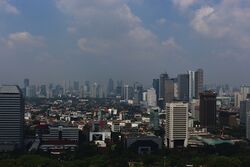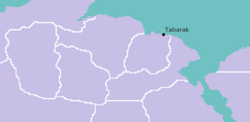Tabarak
Tabarak, Tabarak State | |
|---|---|
National and State Capital | |
| City of Tabarak | |
 Skyline of West Tabarak viewed across the Bana River from East Tabarak | |
| Nickname(s): "The Big House", "Meso Town", "Heimatstadt" | |
| Motto: "Freedom in the name of knowledge" | |
 Location of Tabarak in Tabarak State, north west Mesoland | |
| Country | |
| State | Tabarak |
| County | Tabarak County, Caldwell County, Madison County |
| Established | c. 920 AD |
| Named for | Tabarak Nunat |
| Government | |
| • Type | Mayor–Council |
| • Mayor | Warren Jackson (New Party) |
| • Council | Tabarak City Council |
| Area | |
| • National and State Capital | 1,300 sq mi (3,000 km2) |
| • Metro | 4,600 sq mi (12,000 km2) |
| Elevation | 184 ft (56 m) |
| Population (2019) | |
| • National and State Capital | 33,276,445 |
| • Rank | Mesoland: 1st |
| • Density | 7,234.01/sq mi (2,793.07/km2) |
| • Urban | 14,962,000 |
| • Metro | 33,276,445 |
| Time zone | Central Meso Time |
| • Summer (DST) | Central Daylight Saving Time |
| Meso Area Code | 100 |
Tabarak, formally the City of Tabarak, is the capital of Mesoland. The city is thought to have first been founded under its current name by a group of merchants in 920 AD with the area at the mouth of the Bana River upon which Tabarak is situated having been inhabited for millenia. The city was named for the local Sumvesi Clan High Chief Tabarak Nunat, then a major landowner in the region. The city was officially incorporated and became the national capital on 1st June 1722, simultaneous to the foundation of Mesoland itself. The city is by far the largest in the country and is the seat of the Mesoland federal government and numerous national and international organisations, corporations and agencies. It is an important Astyrian capital and receives over 35 million tourists annually, making it one of the most visited cities in the region.
Having been proscribed in the original Meso constitution to become the national capital upon the foundation of Mesoland, at midnight on 1st June 1722 - mere moments after the constitution had been signed and ratified by the 1722 22 - the feudal Masha Kingdom ceased to exist and its former capital city of Tabarak became the capital of the new nation of Mesoland, which also inherited the entirety of the rest of the land that made up the Masha Kingdom.
Tabarak is part of a large metropolitan area in northern Mesoland comprising of a number of other smaller cities in Tabarak State that are operated under the jurisdiction of Tabarak City Council, and therefore included in the area and population statistics for the city. The population of this greater Tabarak conurbation was 33,276,445 as of May 2019, however the population of the original city proper, the borders of which align exactly to those of Tabarak County, was 14,962,000 as of May 2019.
The three central branches of the Meso federal government are based in Tabarak: the Mesoland federal senate and the Mesoland federal parliament (legislative), the president (executive) and the Mesoland Supreme Court (judicial). Tabarak is home to many of Mesoland's most iconic locations, including dozens of museums and monuments that can be found across the city. The city is host to dozens of embassies, primarily those of other Astyrian nations, as well as the headquarters of a number of banks, corporations, unions, non-profits and national agencies. The top 20 largest companies in Mesoland are all headquartered in Tabarak.
Mayoral elections take place in the city every four years on even numbered years whilst the elections to the 20 member council that also govern the city are every four years on odd numbered years. The city's metropolitan area is represented by 4 of the 5 Tabarak State senators (each state has 5 senators, voted for once every 5 years alongside the president) and 60 of Tabarak State's 75 MPs (out of a total number of 450 MPs, voted for once every 3 years).
